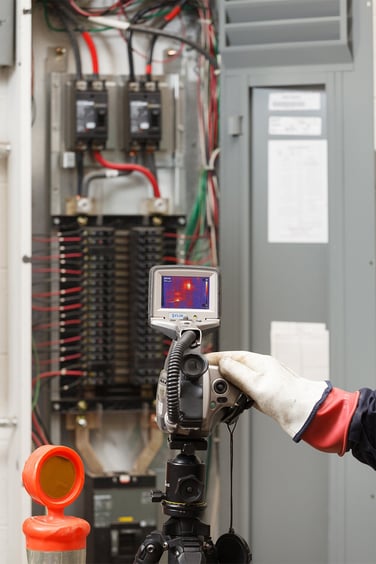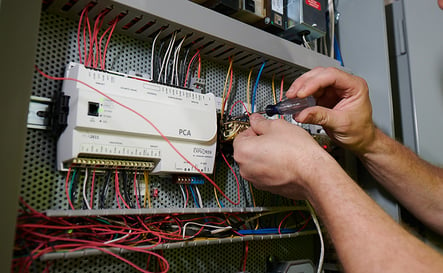The direction and quality of your preventative maintenance will be a deciding factor in how long your equipment runs trouble-free and ultimately how long it lasts.
Below, we’ll cover some tips to make sure you’re getting the most out of your electrical maintenance program.
Maintaining Electrical Outlets Keeps Employees and Work Environments Safe
 Damaged or worn electrical outlets can cause injuries, like electrocution, and fires in commercial or industrial settings. Below are some signs that your outlets may be damaged, and their avoidable causes.
Damaged or worn electrical outlets can cause injuries, like electrocution, and fires in commercial or industrial settings. Below are some signs that your outlets may be damaged, and their avoidable causes.
Loose Plugs:
When inserting a plug, it should feel snug -- not tight or overly loose. This could be a sign of outlet wear, or misuse when unplugging devices (always unplug from the grip, don’t pull on the cord).
Cracked or Warm Outlets:
If an outlet is cracked, or if it feels warm to the touch, it should be inspected by an electrician. This is often an indicator that it was improperly wired, or that the wiring may have been damaged -- a common cause of electrical fires. It can also mean the spring tension inside the receptacle has worn down and is in need of replacement.
Testing Ground Fault Circuit Interrupters:
Ground Fault Circuit Interrupters (GFCI) outlets are required by electrical code in areas where water may come into contact with the outlet. If water comes into contact with the outlet, the GFCI will trip, cutting the electrical connection and avoiding shock or electrocution. You can test the GFCI by pushing the button -- anything plugged in should turn off immediately. If it doesn’t, call a qualified electrician.
Using Surge Protectors:
Most offices and other commercial facilities use surge protector power strips for their computers, to connect and protect a number of extra devices such as printers, phones, etc. from sudden surges of electricity, which can destroy expensive and critical electronic equipment. Surge protector outlets are now available to install directly into a wall.
There are three levels of surge protection normally used. Service, panel and load (outlets and power strips). The best course of action is to apply all three levels, but for starters, the service is the best place to help keep the surge from entering a building.
Electrical Equipment Inspections Keep You Up to Code
During your annual maintenance checkups, remember to check equipment including:
- Local disconnects for machines and equipment.
- Electrical panels.
- Batteries on battery-powered equipment.
- Wiring terminations in equipment subject to vibration.
- Cord and plug connected equipment.
- Other miscellaneous compromised electrical components such as broken or disconnected conduits, and flexible connections.
Check each of these items for cracks, deterioration, or corrosion. Clear the areas near them of dust and other debris that could cause potential equipment failure or hinder access for your electrical maintenance technician. Remember to turn off power to the machines, wiring, or other equipment before cleaning or performing any type of maintenance.
It’s important to pay attention to performance issues like flickering lights, spontaneously low power, or odd equipment resets. Employee feedback and notes about equipment performance should be considered in any equipment testing and inspection since they’re the people most likely to notice the small electrical hiccups that could be a sign of a failing part or a malfunctioning connection.
During your EPM work, it is a good time to check if your existing installations are up to code. Making these repairs before they become a problem will be another way to keep from unnecessary down-time or failed inspections.
Lighting Inspections Improve Productivity
 Lighting fixtures and systems are designed to be regularly maintained. Even the most expensive lighting fixtures and lamps will require maintenance and eventually dim, then burn out. This can be problematic, as studies show that better lighting leads to more productivity in the workplace -- meanwhile, poor lighting makes it harder for employees to focus on the objects in front of them, or distinguishing objects from the background.
Lighting fixtures and systems are designed to be regularly maintained. Even the most expensive lighting fixtures and lamps will require maintenance and eventually dim, then burn out. This can be problematic, as studies show that better lighting leads to more productivity in the workplace -- meanwhile, poor lighting makes it harder for employees to focus on the objects in front of them, or distinguishing objects from the background.
Be sure to check your exit and emergency lights. Fire and Building inspectors look for these issues during routine inspections. Keeping on top of their functionality will keep you out of their spotlight. These lights are part of your emergency egress system and are critical to guide people out of the building in the event of an emergency.
Lighting is responsible for most of the single-user electrical energy use in commercial and industrial buildings. Well maintained lighting is important for several reasons:
- Clearer visibility means better safety.
- Strong lighting improves productivity.
- Maintained lighting fixtures are more energy efficient.
Another important consideration is lamp lumen depreciation (LLD) —- this is when your lighting fixture loses power and dims over time. Check lighting strength and replace dimmed lights during your regularly scheduled maintenance.
Additionally, your checklist should take luminaire dirt depreciation (LDD) into account. Some lamps and fixtures are more vulnerable to dirt and dust buildup, which causes the light fixture to emit less light. Lighting fixtures should be cleaned regularly as well.
As you inspect your lighting, be aware of areas where LED replacement lighting could create a safer, healthier or more productive workspace. Your electrician can help identify areas for improvement. LED lighting will also save energy and energy costs.
Fire Safety Testing Saves Lives
Failing smoke alarms and carbon monoxide detectors will not only cost you money in safety code violations, but it can also pose a serious health risk that could lead to accident, injury and thousands of dollars in fines and payouts.
While it is critical that your smoke alarm and carbon monoxide detectors are inspected regularly by a NICET (National Institute for Certification of Engineering Technologies) certified technician, you can perform a maintenance check on your own in between inspections in order to thoroughly guarantee functionality. Consider self-inspecting every six months.
There are three steps to checking each alarm.
- Visual Checks: Visually inspect the alarms for cracks, deterioration, and other damage. Assess whether any changes in building design or room layout (expanded rooms for instance) mean you will need more alarms. You will also want to look for physical instructions, proper device orientation, physical damage, and dirt (dust and debris can cause problems with alarm sensitivity).
- Testing: Testing and recertification is generally required on an annual basis by a NICET certified testing agency to verify its proper operation and provide documentation for both insurance companies and the fire marshal. Periodic testing ensures your alarm systems are functioning properly. This is done by activating each component of the system such as the alarm, the strobe light, and more. If your building’s smoke alarms are wired to other systems such as an elevator kill switch or a sprinkler system, those connections must be tested as well.
- Maintenance: Failing or damaged systems or components should be fixed immediately. Because of the safety risk, it’s a violation of code to operate without functional fire and carbon monoxide systems and work should be stopped until repairs are made.
On paper, these maintenance procedures may seem simple and inconsequential. However, integrating these small but effective protection measures into your company’s regular processes and procedures can save you thousands of dollars in repairs, work outages, loss of productivity, and machinery replacements.
Do you need help designing your own electrical preventative maintenance plan? Download our pre-made EPM checklist here [insert link] to establish your preventative maintenance routine. For answers to your questions or to schedule a service call dial 262-781-1500 or request a quote on our website. More efficient equipment management is at your fingertips today.
